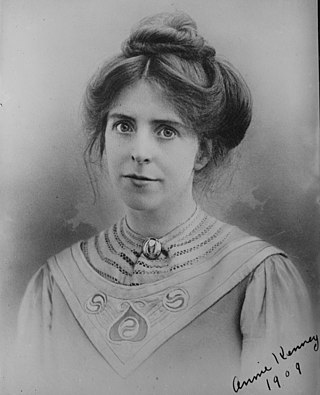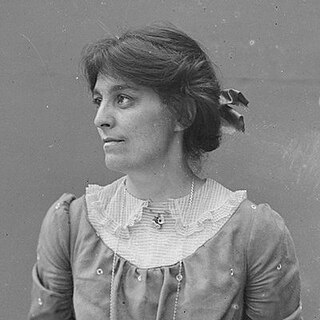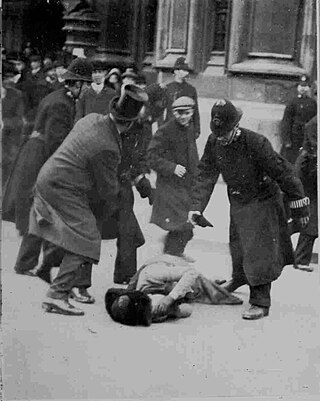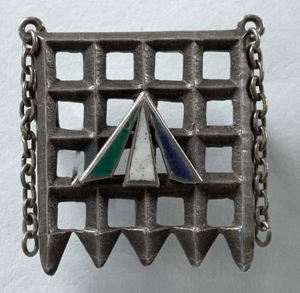
The WSPU Holloway Banner is a suffragette banner designed by Scottish artist Ann Macbeth. [1] [2] [3] [4]

The WSPU Holloway Banner is a suffragette banner designed by Scottish artist Ann Macbeth. [1] [2] [3] [4]
The banner consists of 80 pieces of linen, each embroidered with the signatures of those women who had participated in hunger strikes in support of the cause of women's suffrage. The pieces are bordered by green and purple. [5] Along the top is embroidered "Women's Social and Political Union" in the Art Nouveau style. Also at the top are the names of some leaders of the women's suffrage movement, Annie Kenney, Christabel Pankhurst and Emmeline Pankhurst.
The banner was originally designed as a friendship quilt, [6] and converted into a banner with the addition of carrying poles. [7] It was donated by Macbeth to a bazaar held by the W.S.P.U. at Charing Cross Halls in Glasgow on 28 April 1910. [2] It was bought for £10 by Emmeline Pethick-Lawrence, Baroness Pethick-Lawrence. [8]
The banner was carried in the 'From Prison to Citizenship' procession held in June 1910.
The names of Christabel Pankhurst, Emmeline Pankhurst, Emmeline Pethick-Lawrence and Annie Kenney appear at the tip of the banner around the letters of WSPU. [9]
Image of banner at Museum of London: https://collections.museumoflondon.org.uk/online/object/91239.html

The Women's Social and Political Union (WSPU) was a women-only political movement and leading militant organisation campaigning for women's suffrage in the United Kingdom founded in 1903. Known from 1906 as the suffragettes, its membership and policies were tightly controlled by Emmeline Pankhurst and her daughters Christabel and Sylvia. Sylvia was eventually expelled.

Frederick William Pethick-Lawrence, 1st Baron Pethick-Lawrence, PC was a British Labour politician who, among other things, campaigned for women's suffrage.

Ann "Annie" Kenney was an English working-class suffragette and socialist feminist who became a leading figure in the Women's Social and Political Union. She co-founded its first branch in London with Minnie Baldock. Kenney attracted the attention of the press and public in 1905 when she and Christabel Pankhurst were imprisoned for several days for assault and obstruction related to the questioning of Sir Edward Grey at a Liberal rally in Manchester on the issue of votes for women. The incident is credited with inaugurating a new phase in the struggle for women's suffrage in the UK with the adoption of militant tactics. Annie had friendships with Emmeline Pethick-Lawrence, Baroness Pethick-Lawrence, Mary Blathwayt, Clara Codd, Adela Pankhurst, and Christabel Pankhurst.

Emmeline Pethick-Lawrence, Baroness Pethick-Lawrence was a British women's rights activist and suffragette.

A suffragette was a member of an activist women's organisation in the early 20th century who, under the banner "Votes for Women", fought for the right to vote in public elections in the United Kingdom. The term refers in particular to members of the British Women's Social and Political Union (WSPU), a women-only movement founded in 1903 by Emmeline Pankhurst, which engaged in direct action and civil disobedience. In 1906, a reporter writing in the Daily Mail coined the term suffragette for the WSPU, derived from suffragist, in order to belittle the women advocating women's suffrage. The militants embraced the new name, even adopting it for use as the title of the newspaper published by the WSPU.
Shoulder to Shoulder is a 1974 BBC television serial and book relating the history of the women's suffrage movement, both edited by Midge Mackenzie. The drama series grew out of discussions between Mackenzie and the actress and singer Georgia Brown, who was dissatisfied at the lack of decent roles for women in TV drama. Brown enlisted the producer Verity Lambert in the project she and Mackenzie were devising to dramatise the struggle for women's suffrage, and the three women presented the idea to the BBC, which gave approval for the series. Originally they had hoped to use only female script writers but this proved impracticable. Male writers were used and the three female originators of the project later said they needed to remove from their scripts a number of 'innuendoes, misconceptions and untruths' indicative of what Georgia Brown termed "the male point of view".

Mary Elizabeth Phillips was an English suffragette, feminist and socialist. She was the longest prison serving suffragette. She worked for Christabel Pankhurst but was sacked; she then worked for Sylvia Pankhurst as Mary Pederson or Mary Paterson. In later life she supported women's and children's organisations.

Jessica "Jessie" Kenney (1887–1985) was an English suffragette who was jailed for assaulting the Prime Minister and Home Secretary in a protest to gain suffrage for women in the UK. Details of a bombing campaign to support their cause were discovered by the authorities in her flat when Kenney was sent abroad to convalesce. She later trained as a wireless operator but worked as a stewardess.
Jane Esdon Brailsford, née Jane Esdon Malloch, was a Scottish suffragette.

Mabel Kate Tuke born Mabel Kate Lear was a British suffragette known for her role of honorary secretary of the militant Women's Social and Political Union.

Ada Cecile Granville Wright was an English suffragette. Her photo on the front page of the Daily Mirror on 19 November became an iconic image of the suffrage movement.

Lucy Minnie Baldock was a British suffragette. Along with Annie Kenney, she co-founded the first branch in London of the Women's Social and Political Union.

Women's Sunday was a suffragette march and rally held in London on 21 June 1908. Organised by Emmeline Pankhurst's Women's Social and Political Union (WSPU) to persuade the Liberal government to support votes for women, it is thought to have been the largest demonstration to be held until then in the country.

Lillian Dove-Willcox (1875–1963) was a British suffragette who was a member of Emmeline Pankhurst's personal bodyguard.

Louise Mary Eates was a British suffragette, chair of Kensington Women's Social and Political Union and a women's education activist.

Eleanor Grace Watney Roe (1885–1979) was Head of Suffragette operations for the Women's Social and Political Union. She was released from prison after the outbreak of World War I due to an amnesty for suffragettes negotiated with the government by the WSPU.

Minnie Turner was a British suffragette who was known for running a guest house, the "Sea View", in Brighton. In November 1911 she was arrested for breaking a window in the Home Office for which she received a 21 day sentence Holloway Prison.

The Holloway brooch was presented by the Women's Social and Political Union (WPSU) to women who had been imprisoned at Holloway Prison for militant suffragette activity. It is also referred to as the "Portcullis badge", the "Holloway Prison brooch" and the "Victoria Cross of the Union".
Patricia Woodlock was a British artist and suffragette who was imprisoned seven times, including serving the longest suffragette prison sentence in 1908 ; she was awarded a Women's Social and Political Union (WSPU) Hunger Strike Medal for Valour. Her harsh sentence caused outrage among supporters and inspired others to join the protests. Her release was celebrated in Liverpool and London and drawn as a dreadnought warship, on the cover of the WSPU Votes for Women newsletter.

Katherine Douglas Smith was a militant British suffragette and from 1908 a paid organiser of the Women's Social and Political Union (WSPU). She was also a member of the International Suffrage Club.
{{cite book}}: CS1 maint: location missing publisher (link) CS1 maint: others (link)